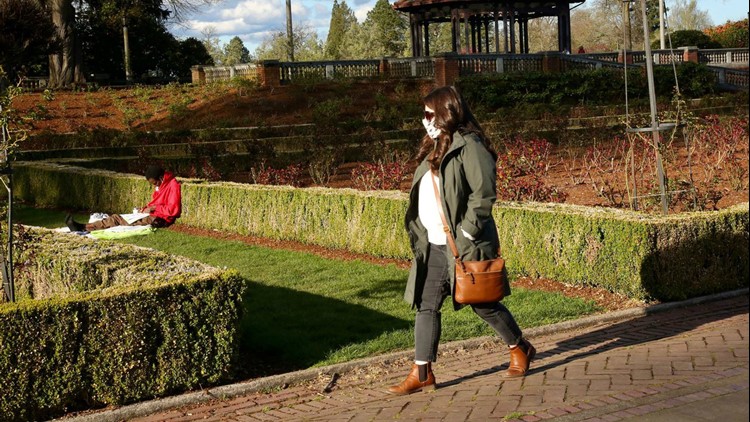PORTLAND, Ore — Gov. Kate Brown urged Oregonians on Tuesday to follow new guidelines from the Centers for Disease Control and Prevention by wearing homemade, cloth masks in an effort to stop the spread of the novel coronavirus.
The CDC, along with health officials from Multnomah County, Clackamas County and Washington County, say that homemade face coverings can help prevent asymptomatic people from inadvertently transmitting COVID-19 to others. Masks should not be used as a replacement for other social distancing measures and people should remain at home, whenever possible.
“The best way to stop the spread of COVID-19 is to keep following the strict social distancing guidelines we put in place early in our outbreak," Brown said in a statement. “Staying home is saving lives in Oregon. When you’re in public for essential activities like grocery shopping, stay six feet away from other people. Continue to wash your hands and properly cover your coughs and sneezes.”
While the CDC still does not recommend wearing N95 masks or surgical face masks because those masks are in short supply and need to be left for hospital staff members and first responders, they do recommend wearing cloth face coverings in public settings when other social distancing measures are difficult to maintain, such as at grocery stores and pharmacies.
But homemade masks won’t be effective if you don’t know how to properly care for them. Here is look at what health experts are recommending when it comes to caring for masks:
How should I clean my mask?
Jennifer Vines, a doctor and the lead health officer for the tri-county region, said that homemade face coverings should be washed with soap and water, just like any other piece of clothing. While Vines said that there are no special recommendations for laundering fabric masks, she said she would recommend washing homemade masks in a regular washing machine with detergent and warm water before drying the masks in a dryer on a high setting, if possible.
How often should I clean my mask?
Vines recommends that Oregonians wash face coverings at least once a day or have two face coverings on hand, so that one can be worn while the other is being washed. It is important to dry your mask throughly before reuse. If a mask is wet or soiled, it should not be worn.
“If it is wet or soiled, it should be laundered and you should swap it out for a fresh one or wait to clean it to use it,” said Vines in a conference call with reporters last Friday.
Chunhuei Chi, a professor in the global health program at Oregon State University, also recommends having multiple face coverings to ensure that you always have a clean option available. However, Chi said that wearing a mask multiple days in a row without cleaning it would be OK, if the mask was only worn for a short period of time.
“If it is for grocery shopping only, although ideally one would like to wash them daily, but if it is not feasible, one can wear them in multiple days,” Chi said. “If one wears a mask for heavy use, such as commuting in public transportation with many people, plus wearing them in the workplace, then one should disinfect the mask daily.”
In an opinion piece for the Washington Post, Joseph G. Allen, an assistant professor of exposure and assessment science at Harvard University’s T.H. Chan School of Public Health, said that mask wearers with multiple masks could also opt to place used masks in individual paper bags after use. After five days, the virus should die off.
How many times can I wear a homemade mask?
There is not a set number of times that homemade masks can be worn, but Clackamas County Health Officer Sarah Present said that masks do not work if they are damaged. It is important to check that your mask is intact after every wash. Vines said to dispose of any mask that shows visible wear, is torn or has fabric that has become too thin. Homemade masks should securely cover both the nose and mouth.
How do I keep my mask clean while wearing it?
Health experts advise mask wearers to wash their hands before putting on a mask. When putting on or removing your mask, it is important to only touch the straps that keep the mask secure. Do not touch your face or the front of the mask to adjust it.
“If you are going to use a face mask that you are going to make yourself, it should be clean,” Vines said. “You should be careful not to touch your face to adjust it. You want to be using good hand hygiene if you’re going to be touching your face to adjust it. If you are sick, I would say this is not an option for you. You should be staying at home. Everybody else should continue to follow our statewide stay at home orders.”
Should my child wear a mask in public as well?
The CDC recommends that children under the age of 2 and anyone who can’t remove a face covering on their own do not wear masks.
Present said that she has not heard of specific guidelines for children of other ages, but said that several face coverings, including ski masks and bandanas, could be appropriate for children. Children and adults should only wear face coverings that they can breathe easily through.
“Keeping the social distancing and just doing all that we can to help protect the spread of the disease is what’s going to help us,” Present said. “I think everyone should just try to do their best. We don’t have any specific guidance for young children.”
What else do I need to know if I want to wear a mask in public?
Some materials will work better than others for homemade masks. A group of Cambridge University researchers tested various materials and determined that the best materials for homemade face coverings were cotton T-shirts, when filtration and breathability were considered. The Cambridge study didn’t specify the T-shirt’s thickness or the pillowcase’s thread count. The Oregonian/OregonLive took a look at several studies to provide information on the best materials for homemade masks.
The Oregonian/OregonLive has also put together a tip sheet for Oregonians planning to wear homemade, cloth face coverings in public and produced multiple videos on ways to sew homemade masks or create homemade masks with household items.
This article was originally published by the Oregonian/OregonLive, one of more than a dozen news organizations throughout the state sharing their coverage of the novel coronavirus outbreak to help inform Oregonians about this evolving health issue.



